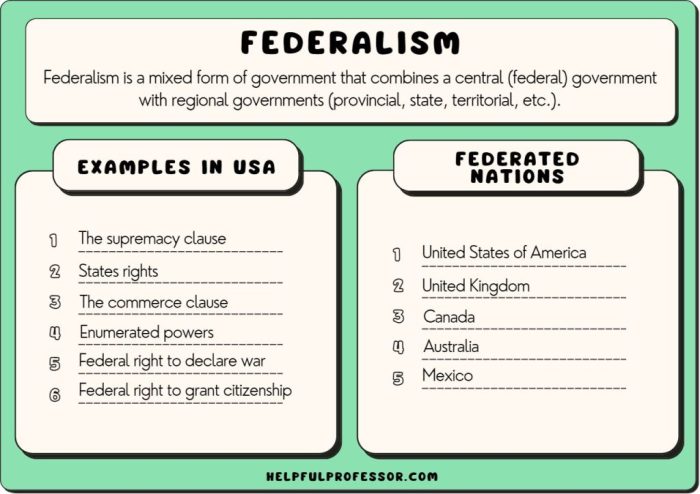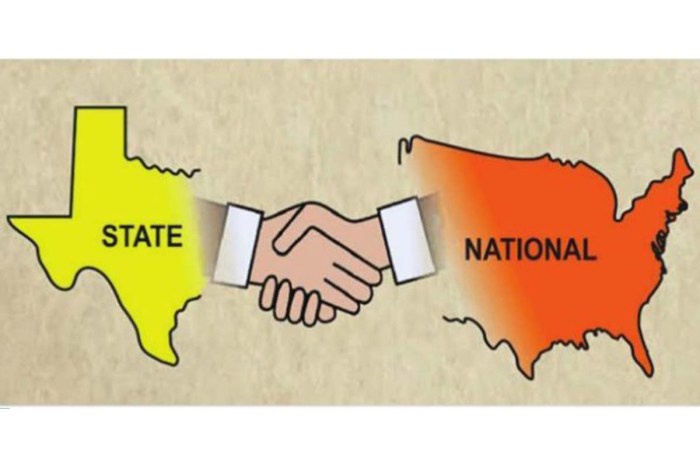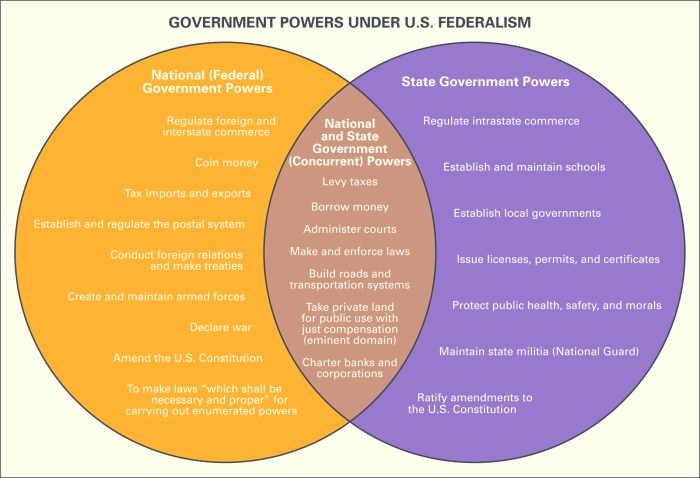How does cooperative federalism work in the united states apex – Cooperative federalism, a cornerstone of American governance, embodies a unique partnership between the federal government and states, fostering shared responsibilities and intertwined decision-making. This intricate system has evolved over time, shaping the nation’s political landscape and impacting the lives of its citizens.
The principles of cooperative federalism, including shared power, dual sovereignty, and intergovernmental cooperation, provide the foundation for this collaborative framework. These principles define the relationship between the federal government and the states, ensuring a balance of authority and preserving local autonomy while addressing national concerns.
1. Definition of Cooperative Federalism

Cooperative federalism is a system of government in which power is shared between the national government and state governments. In the United States, cooperative federalism is based on the principle of dual sovereignty, which means that both the federal government and the states have the authority to govern within their respective spheres of influence.Cooperative
federalism is implemented through a variety of mechanisms, including grants-in-aid, cross-cutting mandates, and intergovernmental agreements. Grants-in-aid are financial assistance provided by the federal government to state and local governments to support specific programs or services. Cross-cutting mandates are federal laws that require states to implement certain programs or meet certain standards.
Intergovernmental agreements are formal agreements between the federal government and state or local governments that establish cooperative relationships for the provision of services or the implementation of programs.
2. Principles of Cooperative Federalism: How Does Cooperative Federalism Work In The United States Apex
Cooperative federalism is guided by several key principles, including shared power, dual sovereignty, and intergovernmental cooperation. Shared power means that both the federal government and the states have the authority to govern within their respective spheres of influence. Dual sovereignty means that both the federal government and the states are sovereign entities with the authority to make and enforce laws within their own jurisdictions.
Intergovernmental cooperation means that the federal government and the states work together to achieve common goals.These principles shape the relationship between the federal government and the states. Shared power means that neither the federal government nor the states can exercise complete control over any single issue.
Dual sovereignty means that the federal government and the states have the authority to make and enforce laws within their own jurisdictions, even if those laws conflict with each other. Intergovernmental cooperation means that the federal government and the states must work together to achieve common goals, even if they have different priorities.
3. Structures of Cooperative Federalism

Cooperative federalism operates through a variety of structures, including grants-in-aid, cross-cutting mandates, and intergovernmental agreements. Grants-in-aid are financial assistance provided by the federal government to state and local governments to support specific programs or services. Cross-cutting mandates are federal laws that require states to implement certain programs or meet certain standards.
Intergovernmental agreements are formal agreements between the federal government and state or local governments that establish cooperative relationships for the provision of services or the implementation of programs.Grants-in-aid are a major tool for implementing cooperative federalism. The federal government provides grants to state and local governments to support a wide range of programs, including education, healthcare, and infrastructure.
Cross-cutting mandates are another important tool for implementing cooperative federalism. The federal government has enacted a number of cross-cutting mandates that require states to implement certain programs or meet certain standards. For example, the Clean Air Act requires states to implement plans to reduce air pollution.
Intergovernmental agreements are a third important tool for implementing cooperative federalism. The federal government has entered into a number of intergovernmental agreements with state and local governments to establish cooperative relationships for the provision of services or the implementation of programs.
For example, the federal government has entered into an intergovernmental agreement with the state of California to establish a cooperative relationship for the provision of healthcare services.
4. Benefits of Cooperative Federalism

Cooperative federalism offers a number of benefits, including increased efficiency, innovation, and responsiveness to local needs. Increased efficiency is a benefit of cooperative federalism because it allows the federal government and the states to share resources and expertise. Innovation is a benefit of cooperative federalism because it allows the federal government and the states to experiment with different approaches to problem-solving.
Responsiveness to local needs is a benefit of cooperative federalism because it allows the states to tailor programs and services to the needs of their citizens.Cooperative federalism has improved governance in the United States in a number of ways. For example, cooperative federalism has led to the development of a more efficient and effective system of healthcare.
Cooperative federalism has also led to the development of a more innovative and responsive system of education.
Popular Questions
What is the primary goal of cooperative federalism?
Cooperative federalism aims to enhance governance by fostering collaboration, efficiency, and responsiveness to local needs, while preserving the balance of power between the federal government and states.
How does cooperative federalism address conflicts between federal and state laws?
Cooperative federalism provides mechanisms for resolving conflicts through intergovernmental cooperation, negotiation, and, in some cases, judicial review to ensure the supremacy of federal law while respecting state autonomy.